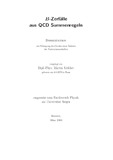Citation link:
https://nbn-resolving.org/urn:nbn:de:hbz:467-2122Files in This Item:
| File | Description | Size | Format | |
|---|---|---|---|---|
| melcher.pdf | 2.08 MB | Adobe PDF |  View/Open |
| Dokument Type: | Doctoral Thesis | metadata.dc.title: | B-Zerfälle aus QCD Summenregeln | Authors: | Melcher, Martin | Institute: | Fachbereich 7, Physik | Free keywords: | CP-Verletzung, Teilchenphysik, B-Physik | Dewey Decimal Classification: | 530 Physik | GHBS-Clases: | UHXN | Issue Date: | 2006 | Publish Date: | 2006 | Abstract: | B -Zerfälle aus QCD Summenregeln Das Standardmodell der Elementarteilchenphysik erklärt die CP -Verletzung genannte Materie-Antimaterie- Asymmetrie durch eine komplexe Phase in der Kopplung der Quarks an das W -Boson, die durch die CKM -Matrix beschrieben wird. Um diesen Ansatz zu überprüfen und seine fundamentalen Parameter, die Einträge der CKM -Matrix, zu bestimmen, müssen schwache Zerfallsprozesse von Hadronen untersucht werden. Wichtige Einblicke bieten zum Beispiel B -Meson-Zerfälle in zwei leichte Pseudoskalare ( π , K ). Über sie konnen die CKM -Winkel α und γ bestimmt werden. Allerdings wird die theoretische Behandlung der Zerfälle dadurch erschwert, dass gebundene Quarkzustände nicht mit der Storungstheorie beschrieben werden konnen. In der Literatur behilft man sich oft mit Berechnungen im Limes m b → ∞ (schweres Beauty-Quark) und m s → 0 (leichtes Strange-Quark). In QCD Summenregeln konnen die Korrekturen zu dieser Näherung berechnet werden. In B → ππ -Zerfällen zum Beispiel ist die theoretische Vorhersage im Grenzfall m b → ∞ inkonsistent mit den Messdaten. In der vorliegenden Arbeit wurden zusätzlich zu bereits bekannten 1/ m b -Korrekturen die Annihilations-Beiträge zu diesen Zerfällen mit Lichtkegel-Summenregeln berechnet. Sie sind allerdings zu klein, um die Diskrepanz zwischen Theorie und Experiment aufzuheben. Mit der gleichen Methode wurden auch perturbative Korrekturen zu Emissionsdiagrammen neu berechnet. Das Ergebnis ist vergleichbar mit dem anderer Methoden, schließt aber eine neue 1/ m b -unterdrückte starke Phase ein und hängt nicht von der B -Meson-Verteilungsamplitude ab, die noch nicht gut bekannt ist. Darüberhinaus wurden die Effekte der Strange- Quark-Masse in B ( s ) → π K - und KK -Zerfällen berechnet. Dazu wurden prozessunabhängige Großen, die Lichtkegel-Verteilungsamplituden beschreiben, in Zweipunkt-Summenregeln berechnet. Es stellte sich heraus, dass der Grenzwert m s → 0 keine besonders gute Näherung ist, die QCD Summenregeln aber bei endlichem m s eine gute Beschreibung liefern. B -Zerfälle aus QCD Summenregeln In the Standard Model of elementary particle physics, the asymmetry between matter and antimatter, called CP -violation, is explained by a complex phase in the CKM -matrix which governs the coupling of the quarks to the W boson mediating the weak interaction. In order to test this theoretical framework and to determine its fundamental parameters, the CKM matrix elements, weak decays of hadrons have to be investigated. One interesting class of such decays are those of B mesons to two light pseudoscalars ( π , K ). They are sensitive to the weak CP -violating phases α and γ of the CKM matrix. The theoretical treatment required to extract them from the measured data is however very difficult, as the bound states of quarks cannot be described by perturbation theory. In the literature, the limits m b → ∞ (heavy beauty quark) and m s → 0 (light strange quark) are often used in the calculation of physical observables. With the help of QCD twopoint and light-cone sum rules, corrections to this limits can be calculated. In B → ππ decays, for example, one observes a discrepancy between the theoretical description in the m b → ∞ limit and the measured quantities. In this work, the contributions from the annihilation mechanism have been calculated using light-cone sum rules, in addition to several already known 1/ m b -corrections. They were found to be too small to reconcile theory and experiment, however. The same method was also applied to perturbative corrections to the dominant emission diagrams. The latter ones have already been calculated in other methods and the results are consistent with each other. At the same time, the new result includes a new 1/ m b -suppressed strong phase and does not depend on the poorly known distribution amplitude of the B meson. In B ( s ) → π K and KK -decays, the effects of the strange quark mass were calculated. To this end, nonperturbative, process-independent quantities related to the light-cone distribution amplitudes have been computed in two-point sum rules. Using this values, it was found that the m s → 0 limit is not a very good approximation for the decay amplitudes, and that QCD sum rules successfully describe the amplitudes without relying on this limit. |
URN: | urn:nbn:de:hbz:467-2122 | URI: | https://dspace.ub.uni-siegen.de/handle/ubsi/212 | License: | https://dspace.ub.uni-siegen.de/static/license.txt |
| Appears in Collections: | Hochschulschriften |
This item is protected by original copyright |
Page view(s)
449
checked on Dec 4, 2024
Download(s)
97
checked on Dec 4, 2024
Google ScholarTM
Check
Items in DSpace are protected by copyright, with all rights reserved, unless otherwise indicated.

